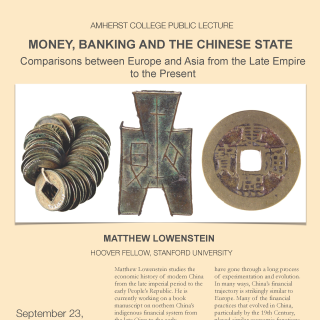Events & Calendars "Money, Banking and the Chinese State: Comparisons Between Europe and Asia from the Late Empire to the Present"
Skip to Main Content
In this talk, Matthew Lowenstein discusses the deep history of money and banking in China. China’s use of gold, silver and copper as money dates back before recorded history, while it has been minting coins since at least as far back as the third century B.C. China went on to invent paper money in the Tang Dynasty (618-907 AD). Since then, its institutions of finance and credit have gone through a long process of experimentation and evolution. In many ways, China’s financial trajectory is strikingly similar to that of Europe.
Many of the financial practices that evolved in China, particularly by the 19th century, played similar economic functions to comparable financial instruments. But China’s unique historical, political, social and geographical endowments meant that its monetary system was built out of distinct institutions and evolved in an entirely different context. One particular difference this lecture will highlight is the role of the state. In the West, banking and money evolved in large part out of various state actors’ needs to finance war. In the Chinese case, most war-oriented currencies failed due to state profligacy. In China, commerce rather than interstate competition proved the driving factor in developing a more stable, more complex and more efficient financial system.
Matthew Lowenstein (Hoover Fellow, Stanford University) studies the economic history of modern China from the late imperial period to the early People’s Republic. He is currently working on a book manuscript on northern China’s indigenous financial system from the late Qing to the early Republican period (1820–1911). Lowenstein received his Ph.D. in history from the University of Chicago and an MBA from Columbia Business School. Lowenstein previously worked as a securities analyst in Beijing and New York, covering the Chinese financial sector.
Contact Info
 @amherst.edu
@amherst.edu